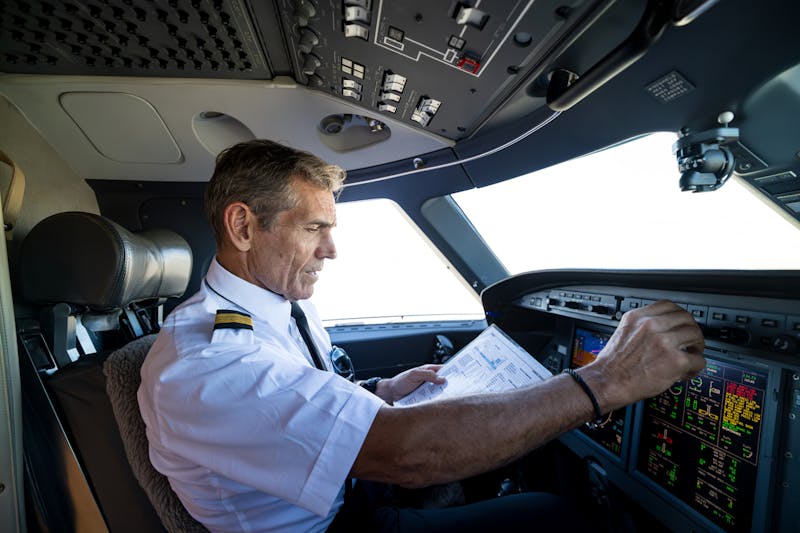Contact Us
Complete the form below for a free case evaluation.

Modern aviation is safer than ever, but the consequences can be catastrophic when something goes wrong. Despite advancements in technology, navigation systems, and aircraft design, one factor remains a leading cause of aviation accidents: pilot error.
Pilots carry immense responsibility when flying a commercial jetliner, a private aircraft, or a cargo plane. A single misjudgment or moment of inattention can result in tragedy. But what exactly constitutes pilot error? And how does it lead to accidents in the air or on the runway?
If you’ve been injured in an aviation accident, it’s imperative to understand the role of pilot error in aviation accidents, the most common types of mistakes, and how investigations determine whether negligence was involved. Securing representation from an aviation attorney at Webster Vicknair Macleod is also in your best interest.
Pilot error refers to any action or inaction by a pilot contributing to an accident or incident. This could be a mistake made during takeoff, an error in judgment during flight, or a failure to follow proper landing procedures.
Importantly, pilot error doesn’t always mean the pilot acted recklessly or intentionally caused harm. But it does mean their conduct fell below the standard expected of a reasonably competent aviator in similar circumstances.
Pilot error can involve:
In many cases, pilot error isn’t the only cause of an aviation accident, but is often the primary or contributing factor.
According to the Federal Aviation Administration (FAA) and the National Transportation Safety Board (NTSB), pilot error accounts for 60–80 percent of aviation accidents. It is the most cited cause in general aviation (private planes) and commercial aviation incidents.
While commercial airline travel in the U.S. is statistically very safe, general aviation, such as charter planes and recreational aircraft, experiences far higher rates of crashes, and pilot error is a significant reason why.
Pilots must constantly make decisions under pressure. Choosing whether to proceed with a landing during poor weather or deciding how to respond to an engine warning can mean the difference between a safe flight and a fatal crash.
Common decision-making errors include:
These mistakes often arise from overconfidence, poor training, or external pressure to stay on schedule.
Aircraft operations involve checklists and standard operating procedures (SOPs) for a reason. Skipping steps or rushing through checks can result in missed mechanical issues or incorrect system settings.
Procedural errors can involve:
Even minor lapses can lead to critical system failures in flight.
Clear and timely communication between pilots and air traffic control (ATC), co-pilots, and ground crews is vital. Miscommunication can lead to runway incursions, wrong-altitude flights, or missed warnings.
Examples include:
In multi-crew aircraft, cockpit resource management (CRM) plays a major role in ensuring safe operations.
Fatigue dulls reaction time, impairs judgment, and increases the risk of error, especially during critical phases of flight like takeoff and landing. Commercial pilots must comply with strict rest requirements, but those rules don’t always apply to private or charter pilots.
In rare but serious cases, pilots may also be impaired by:
Fatigue-related errors are often difficult to detect until after an accident has occurred.
Situational awareness means understanding where you are, what’s happening around you, and how your aircraft performs. Pilots who lose track of these elements may drift off course, descend too quickly, or misjudge altitude during approaches.
This can result in:
Maintaining situational awareness is a fundamental skill that becomes harder under stress, fatigue, or distraction.
While some pilot errors occur in private or recreational aircraft, others have led to high-profile commercial airline disasters. Examples include:
Each case demonstrates how pilot error—whether from inexperience, stress, or oversight—can override even the best equipment and weather planning.
Yes. If a pilot’s negligence leads to an accident that injures or kills passengers, they or their employer may be held liable. Victims and their families can file personal injury or wrongful death lawsuits depending on the circumstances.
Liable parties may include:
To succeed in a claim, you must prove:
After a crash or serious incident, the National Transportation Safety Board (NTSB) investigates the cause of the incident. Their analysis includes:
The NTSB may identify pilot error as the “probable cause” or a contributing factor. Their findings can support a legal claim, but civil attorneys often conduct separate investigations to identify liability.
Flying will never be completely risk-free, but aviation professionals have a duty to reduce avoidable mistakes. Pilot error, whether due to inattention, poor judgment, or fatigue, can turn a routine flight into a fatal disaster.
If you or a loved one has been injured in an aviation accident, it’s essential to understand your rights. Our skilled aviation accident attorneys' thorough investigation and legal evaluation can determine whether pilot error was to blame and whether compensation may be available for medical costs, lost income, pain, or loss.
If you suspect pilot error played a role in a crash that harmed you or a loved one, contact us online to schedule a confidential consultation with our team at Webster Vicknair Macleod. We have the experience, resources, and dedication to pursue justice in even the most complex aviation cases.
Federal Aviation Administration. (2006). Human factors associated with approach and landing accidents (Report No. DOT/FAA/AM-06/18). U.S. Department of Transportation. https://www.faa.gov/sites/faa.gov/files/data_research/research/med_humanfacs/oamtechreports/200618.pdf
American Bar Association. (n.d.). Negligence. https://www.americanbar.org/groups/public_education/resources/law_issues_for_consumers/everydaylaw0/health_care/personal_injury/negligence/
National Transportation Safety Board. (n.d.). Home [Homepage]. https://www.ntsb.gov/Pages/home.aspx
Complete the form below for a free case evaluation.
© Webster Vicknair Macleod. All Rights Reserved.